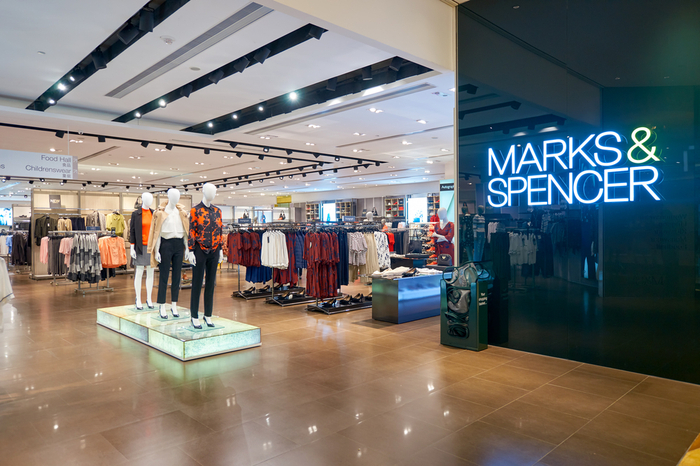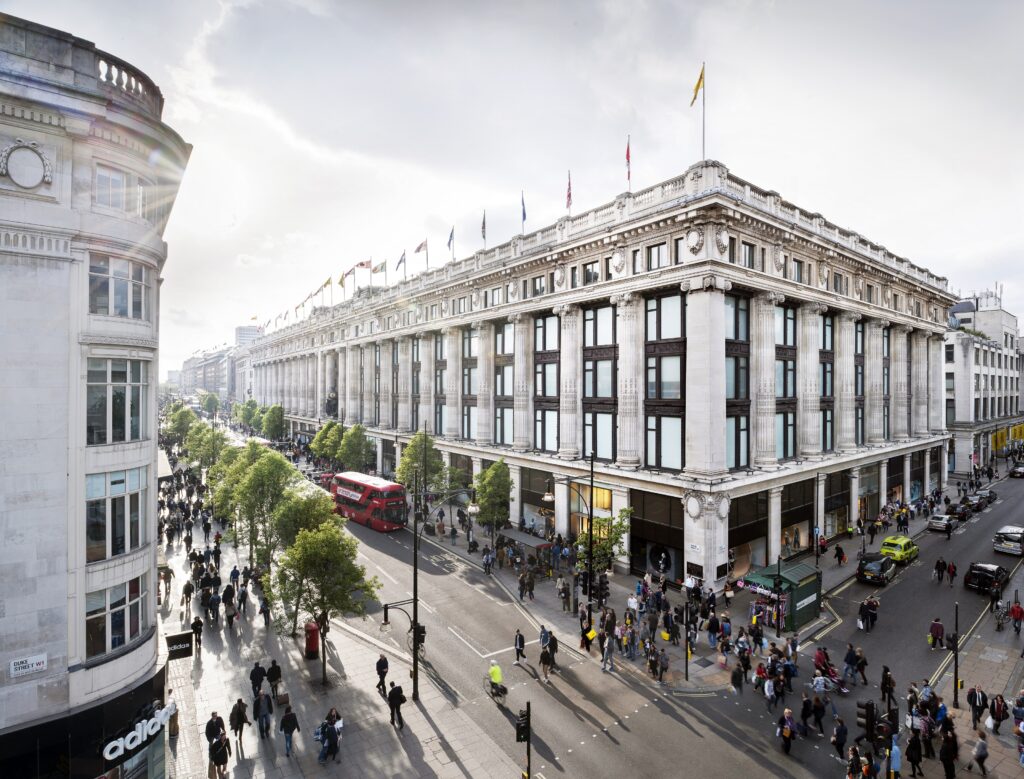The question of whether or not Marks & Spencer is a department store and the debate it provokes is not a new one.
After all, the 137-year old retailer specialises in selling across three “departments” – clothing, home and food. In many ways, M&S fits into the definition of a typical department store: a large retail establishment offering a wide variety of merchandise organised into separate departments. M&S’s full-line stores – those that house clothing, home and food under one roof – arguably fall under this umbrella.
However, M&S has clarified it has zero aspirations to become a department store, let alone be known as one.

“We said at our half year results that we want to build a curated set of brands and merchandise, largely for our online business, but also to fill in some of that excess space we have in stores,” M&S chief executive Steve Rowe explained.
“We’ve got no intention of turning M&S into a department store, at all.
“This is about finding and partnering with adjacent brands – adjacent in terms of style; adjacent in terms of customer base, that enhance what M&S offer and make it the place to go to for an online shop.”

M&S hasn’t always been opposed to becoming a department store. In fact, in 2013, it said it was aiming to win back shoppers by making its stores look more like them.
While then-chief executive Marc Bolland argued that M&S was not turning into a department store, it said it was “departmentalising the shopping journey” to improve the “shopability”. This included dividing M&S’s top 15 stores into near-separate rooms.
Bolland had been under pressure to improve womenswear sales after The Guardian reported that his job was on the line if clothing sales did not show signs of growth after two years of consecutive decline.

Under Rowe’s leadership, M&S has been undergoing a protracted turnaround strategy of sorts – especially in the retailer’s embattled clothing & home department. This has led to store closures, rejigging stores to focus just on food, downsizing stores, and thousands of job cuts over the last four or so years.
Earlier this month it saw its clothing and home revenue drop 25.1 per cent to £787 million in the 13 weeks to December 26, driven by an in-store sales plunge of 46.5 per cent as Covid-19 restrictions, such as the second national lockdowns in England, Wales and Northern Ireland, continued to affect trading. On a like-for-like basis, clothing and home sales dropped 24.1 per cent.
M&S’s food division did marginally better as it was allowed to remain open during lockdown restrictions, recording growth of 2.2 per cent to £1.74 billion during the third quarter, and an increase of 2.6 per cent on a like-for-like basis.
Overall, M&S’s third quarter group sales was down 8.4 per cent to £2.76 billion, and in its UK market alone overall sales was down 8.2 per cent to £2.52 billion while like-for-like sales dropped by 7.6 per cent.
Understandably, M&S’s shift away from transforming into a department store comes at a time when department store chains are notably struggling amidst the pandemic.
It’s no secret that mid-market department stores such as House of Fraser, Debenhams, and John Lewis have been faltering for some time now, battling numerous fronts – all of which have since been exacerbated by Covid-19 restrictions.
Most recently, Debenhams announced it would close six stores permanently – including its London flagship store on Oxford Street. The move would affect 320 staff members, and the future of thousands of other staff continues to hang in the balance as Debenhams’ liquidation process looks set to affect its remaining 118 stores.
Prior to this, Frasers Group bosses warned in October that a number of House of Fraser stores would be forced to shut down unless the government reforms the business rates system.

Meanwhile, John Lewis Partnership grabbed headlines in November over plans to scrap 1500 jobs at its head office in an effort to save £50 million as it seeks to secure £300 million in annual savings by 2022. The news came after eight John Lewis stores never reopened following the first UK-wide lockdown during spring, leading to the loss of 1300 jobs. To add to its woes, John Lewis had reported a 10 per cent drop in half-year overall sales in September.
Department stores were once the main attraction on the high street, but in recent years, this has not really been the case. Like other struggling retailers, some department store groups have too many underperforming shops and need to downsize.
Springboard marketing and insights director Diane Wehrle argued that department stores “haven’t changed in 10, maybe 20 years”. She said this was because they have not invested enough in upgrading their shop floors, product ranges or online offerings.
“As we have had access to global products our standards as consumers have increased – we can also buy anything we want online,” she said.
Catherine Erdly, founder of retail consultancy The Resilient Retail Club, explained that department stores have had a bumpy ride and were losing relevance.
“Even the mighty John Lewis has had a tough time during the pandemic and it’s easy to see why M&S would want to avoid going down that route,” she explained.
Julian Dailly, executive vice president of consumer insight and strategy at market researcher Savanta, argued that a department store rebrand would “unsettle M&S’s investors, who have watched the majority of department stores collapse over the last decade”.
Retail expert Nelson Blackley said M&S wouldn’t benefit as much as from rebranding as a department store as it would in downsizing its store estate.
“There are very successful department stores in the UK, such as Harvey Nichols and Selfridges, so it’s the way they are run, as always, that determines their survival or not,” he said.
“Whilst established department store chains such as Beales, House of Fraser and Debenhams have all gone into administration, that was mostly to do with the way they operated and in many cases the levels of debt they carried, rather than just because of their format.
“M&S will only benefit from one thing – and its unconnected with whether or not they might be described as a department store.
“That it a rapid reduction in the total number of stores they have across the UK and a close look at store productivity – in other words quickly establishing a right shaped store estate.”
As part of its Never the Same Again strategy, M&S announced plans to grow a curated portfolio of brand partnerships to help broaden relevance and increase online growth. Rowe said third-party brand acquisitions and partnerships “will not distract from its core clothing range”.
Erdly told Retail Gazette that M&S would be able to offer a wider choice to customers by bringing in outside brands without having to commit to manufacturing – should it transform into a department store.

However, in doing so, M&S would be reliant on these third party brands instead of trading exclusively on the strength of the M&S brand.
“M&S could benefit from becoming a department store if it allowed them to bring in a wider range of products and to be more experimental and to open up to a fresh new audience at a lower risk than manufacturing the goods themselves,” Erdly said.
Blackley argued that there is no real indication M&S would engage in lots of partnership or brand purchases.
“The description that they used last year was ‘cautiously introducing third-party brands’ and ‘rapidly improving the online business’ which appears to be something of a contradiction in focus,” he said.
The first brand to be launched as part of the retailer’s new strategy was contemporary womenswear brand Nobody’s Child last October and M&S initially offered 140 options online, with regular drops of product although half of the initial collection were the brand’s signature dresses. It then introduced exclusively-online womenswear brand Ghost with a 10-piece autumn/winter capsule collection.
“Department stores have had a bumpy ride and are losing relevance with today’s customers”
“Both brands are focused largely on dresses, and that is just not what people are buying during lockdown,” Blackley said.
Most recently, M&S bought upmarket fashion brand Jaeger out of administration, saving it from collapse. However, the deal only pertained to Jaeger’s intellectual property, allowing it to sell Jaeger-branded goods on its website as a third-party brand. This means Jaeger’s standalone stores would shut down.
Erdly said the Jaeger acquisition showed that M&S was looking to do whatever it can to revitalise the mixed fortunes of its womenswear department.
“M&S’s partnerships with Ghost and Nobody’s Child will be an attempt to reach new customers who would not normally have shopped with them and to offer a differentiated clothing range,” she added.
However, Blackley was not convinced. He said any of these three tie-ups – specifically Jaeger – would “turbocharge the M&S online growth by broadening appeal” as the retailer hopes.
“The challenge that M&S have faced for years now is to attract a new and younger demographic into its stores and onto its website,” he said.
“This is still a huge barrier to its future trading success, and the inability to attract to their non-food and clothing aisles the thousands of under 45-year-old shoppers that already frequent their food halls every day remains one of UK retail’s ensuring mysteries.”
Arguably, a department store offers a nostalgic, premium shopping experience, creating latent consumer affection, and average transactions can be relatively high as a result – which may benefit M&S.
However, it’s no secret that footfall in department stores has been declining for years as shoppers have leaned towards online shopping – even before Covid-19.
M&S shift away from a department store concept is reasonable considering the sector requires large amounts of fixed costs and overheads, making them quickly unprofitable, and therefore unattractive for investors.
Nevertheless, the definition of the larger M&S full-service stores – with clothing, footwear, accessories, food, wine, beauty, fresh flowers, homewares, furniture and gifts – may be a department store in the minds of many shoppers. But rather than focus on this, M&S might need to accelerate its Never the Same Again transformation to ensure it has shops in the right locations.
Click here to sign up to Retail Gazette’s free daily email newsletter

















